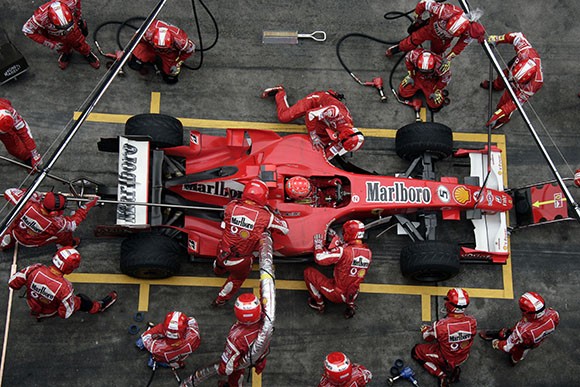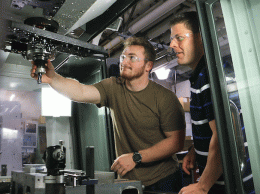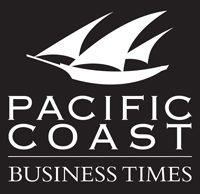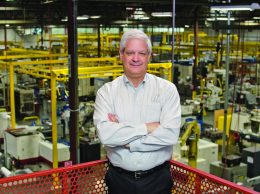
Team Ferrari’s Michael Schumacher makes a pitstop at the Formula One Grand Prix of China. (Bloomberg News file photo)
Some executives take to the golf course to reap the benefits of mixing business and leisure. Gene Haas heads to the race track.
The founder and CEO of Oxnard-based Haas Automation is building a Formula One team that will be the motorsport’s first American-owned entrant in 30 years when it joins the F1 grid in 2016. The operation will stand alongside Stewart-Haas Racing, a NASCAR team Haas founded in 2003 that he now co-owns with stock-car star Tony Stewart, as a platform for the tool manufacturer to engage customers and expand its dealer network.
The NASCAR outfit won the Sprint Cup championship in 2011 and 2014 and counts Danica Patrick and Kurt Busch among its drivers. Its staff of 280 works out of a 200,000-square-foot, state-of-the-art mechanical and testing facility in North Carolina, but so far the operation has been limited to an American audience.
In hopes of amplifying his firm’s global presence, Haas has been quietly assembling an arsenal of industry veterans to undertake the process of building a top-tier Formula One team from scratch — an endeavor the company’s vice president of European operations and special projects, Peter Zierhut, said Haas had “been interested in for a very long time.”
“NASCAR of course is the highest level you can get in the United States in racing,” Zierhut said. “But Formula One is really the pinnacle on the world stage for racing, so [Haas] is finally able to realize that dream and start a Formula One team.”
When Haas Automation’s sales dropped during the recession, prompting staffing cuts at its Oxnard plant, Haas expanded business in international markets.
Though the firm’s products claim a hefty 40 percent of America’s machine tools market, market share overseas is comparably weak, at about 5 percent. According to Zierhut, Haas sees the team, Haas F1, “as an important tool to promote Haas Automation’s products on a world stage.”
“We’re the No. 1 machine tool builder in the entire country,” Zierhut said. “We’re one of the top few in the world, but we’re not there yet.”
Though it lacks popularity in the U.S., F1 racing is a highly respected sport in many European, Middle Eastern and Asian countries and generates an annual $1.8 billion in revenue. The competition is the top class of single-seat auto racing and ruled by a set of strict technical regulations, with points tallied across a series of Grand Prix events in 20 countries. The 2015 season attracted a global audience of 425 million people per race.
But the sport’s pool of competitors is thinning, with its 12-team field thinning to nine in the past three years. Last fall saw British team Caterham fold after running out of money, and its fellow UK competitor Marussia is likely to bow out next.
Though it may have been simpler to buy and rebrand one of these struggling outfits, Haas preferred to do things his way from the ground up.
“That’s evident in the way we’ve built this company. We look at everything and we consider ourselves an extremely efficient operation,” Zierhut said. “Instead of buying someone else’s old race team, he gets to actually start one from scratch and do it in a much more efficient manner — we hope anyway, and we feel that we can do that.”
When Marussia entered receivership last November, Haas bought the team’s headquarters near Oxford to serve as Haas F1’s European base for connecting with suppliers and conducting mechanical rebuilds.
“They had some equipment that was useful to us at that facility, very close to the center of the Formula One world near the Silverstone Formula One race track in the UK, so it was convenient,” Zierhut said.
Haas has already staffed the British facility with industry experts, including team manager Dave O’Neill and chief designer Rob Taylor, both of whom had most recently worked at Marussia, and chief aerodynamicist Ben Agathangelou, who has been head of aerodynamics at Jaguar, Red Bull Racing and Renault F1/Benetton during his 18-year career in Formula One.
And Haas tapped into his NASCAR connections in search of a team principal to oversee operations and caught Günther Steiner, who has worked in F1 since 2001, when he was recruited as the Jaguar team’s managing director by three-time circuit champion Niki Lauda.
The operation’s official home base, however, will remain at the existing Stewart-Haas Racing facilities in North Carolina, and every part in the car will be developed and manufactured at Haas’ Oxnard factory. Since Haas has already invested heavily in the North Carolina compound, the team can maneuver around a lot of the costs that doom smaller competitors.
“Formula One can be a very costly sport but, for example, owning our own wind tunnel eventually can help,” Zierhut said. And Haas doesn’t use just any wind tunnel, but something known as the Windshear — a 180-mph, rolling-road wind tunnel that is the first of its scale available for commercial use.
After absorbing the cost of building their vehicle, Formula One teams pay an entry fee of $500,000, plus a charge of $5,000 per point scored the previous year or $6,000 per point for the constructors’ champion. Drivers must also pay fee of $10,000 plus $1,000 per point for their F1 “Super License.”
Though F1 rules require a team to build its car’s frame itself, other parts can be purchased from a major team. Haas F1 has formed a partnership with Ferrari, who will supply the car’s drive train and engine, and is conducting engineering operations under the wing of the iconic F1 constructor at its testing facilities in Italy.
Agathangelou and Taylor have already delivered a 60-percent scale model of the car Haas F1 hopes to debut in the 2016 series’ opening race at Melbourne, and the team is working with Ferrari to bring that to a full-scale car later this year. Currently, Haas’ technicians are testing the scale model in a Ferrari wind tunnel, but Zierhut said the engineering will eventually be brought back stateside.
According to team principal Steiner, Haas F1 has made great strides toward being competitive when it joins the grid next year, largely thanks to the collaborative nature the operation has adopted.
“The way we’re going about our F1 team is new and different, but it’s working,” Steiner said in a press release. “We’re committed to our plan, we’re committed to F1 and, most importantly, we’re on schedule. This time next year, our cars will have already been tested and we’ll be readying them for Melbourne.”






 Print
Print Email
Email

















